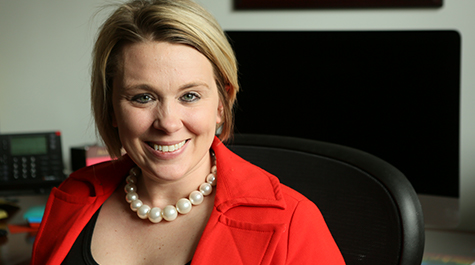$300K grant supports novel approach to engage diverse students in engineering
Meredith Kier, associate professor of science education, has secured a grant worth $300,000 from the National Science Foundation (NSF) for an exploratory research study that will examine how a partnership between engineering undergraduate students from underrepresented backgrounds and middle-school STEM teachers can engage and inspire students in engineering.
In Virginia and across the nation, K-12 school divisions are incorporating a more interdisciplinary approach to STEM education that prioritizes engineering experiences that allow students to solve authentic, real-world problems. But teachers in science and math often do not have the skills and experience to design and implement these learning experiences.
“It’s especially challenging in high-needs schools that serve minority students, as these are often under-resourced and have infrastructural barriers,” says Kier. “I wanted to explore the potential of a new collaborative framework that would not only help teachers gain these skills, but also incorporate underrepresented undergraduate students in engineering — mentors close in age and experience to the middle-school students they’re working with.”
For the project, Kier will match eight underrepresented students from engineering programs at local universities with STEM teacher leaders at all eight middle schools within Newport News Public Schools. Together, the undergraduate students and teachers will collaborate on a semester-long engineering design project for the classroom. Kier and a team of graduate students will analyze how the college students, teachers and middle school students work together — particularly looking at how they communicate, how they overcome stumbling blocks, and how each group is impacted by the experience. The project will take place over two years, with four rounds of engineering design projects completed.
The grant is in a special NSF category for “potentially transformative” research ideas. Called EAGER, or Early Concept Grants for Exploratory Research, funding in this category is earmarked for projects in their early stages that are both high-risk and high-payoff.
Kier is well aware of the potential risks that made the project eligible for this category of funding. “University-level engineering students are typically people who are highly analytical, with an advanced understanding of science and math concepts,” she says. “And they may never have taught before, so there will inevitably be challenges as they work with teachers to design and implement engineering projects that are age-appropriate and engaging for middle-school students.”
However, the potential benefit to participants is huge. Research has shown that interactions with authentic role models in engineering can greatly increase students’ knowledge and identities in STEM fields. This is particularly true for minority students, and these populations are still significantly underrepresented in engineering and related fields.
“Engineering requires diverse perspectives to be at the table,” says Kier. “Underrepresented populations are being left out of the discussions on innovation, and their voices and perspectives aren’t being considered or capitalized on.”
Research has also shown that role models of color are better able to identify with students from marginalized backgrounds, making the learning more relevant and impactful.
Approximately 70% of the student population in Newport News Public Schools are of a minority racial/ethnic background, and over 60% are economically disadvantaged. In collaboration with the school division, Kier chose to conduct the project at the middle school level, as that is a critical point in time where students are beginning to consider subject preferences and career choices.
Kier is working with the Society of Black Engineers, a national organization with chapters at many local universities, to recruit the undergraduate students who will participate in the project. The students will receive stipends and be reimbursed for their travel expenses to and from the schools they work in.
Each round of the project will kick off with a three-day Collaborative Planning Incubator, in which university students and teachers will brainstorm, design and test their engineering projects. The undergraduate students will then join the teachers in their classrooms for six sessions over the course of the semester to implement the project.
Throughout the incubator and the subsequent sessions with students, Kier will use video and audio recordings to examine how the college students, teachers, and middle-school students communicate with one another.
“We’re looking for those points of convergence where each group’s knowledge and experience connect — the moments that help students advance their own creativity, conceptualize real-world problems, and start thinking and designing solutions like an engineer,” says Kier.
She anticipates that the project will significantly benefit the engineering students as well. “The reciprocal process of teaching and learning will help these students develop their ability to articulate problems and solutions, and to communicate about their work both within the field and to the general public.”
At the end of the project, Kier aims to publish findings that outline an innovative and practical model for incorporating career role models into the classroom. Particularly important for Kier is to develop a framework that can be applied in culturally and linguistically diverse schools.
“Opportunities like this are often presented in STEM-specialized schools, but we’ll be implementing the project in eight diverse middle schools, including both specialized magnet schools and general education schools,” says Kier. “Our case studies will examine the nuances of what this type of collaboration can look like in each context.”
Kier is prepared for the challenges of managing a mentoring relationship between two very different sets of spaces and types of knowledge — in fact, she says this where she expects the magic to happen.
“I can’t wait to see this in action,” she says. “I’m excited to see students and engineers together in the classroom, discovering new ways to think creatively and collaboratively and seeing new possibilities for their futures.”
